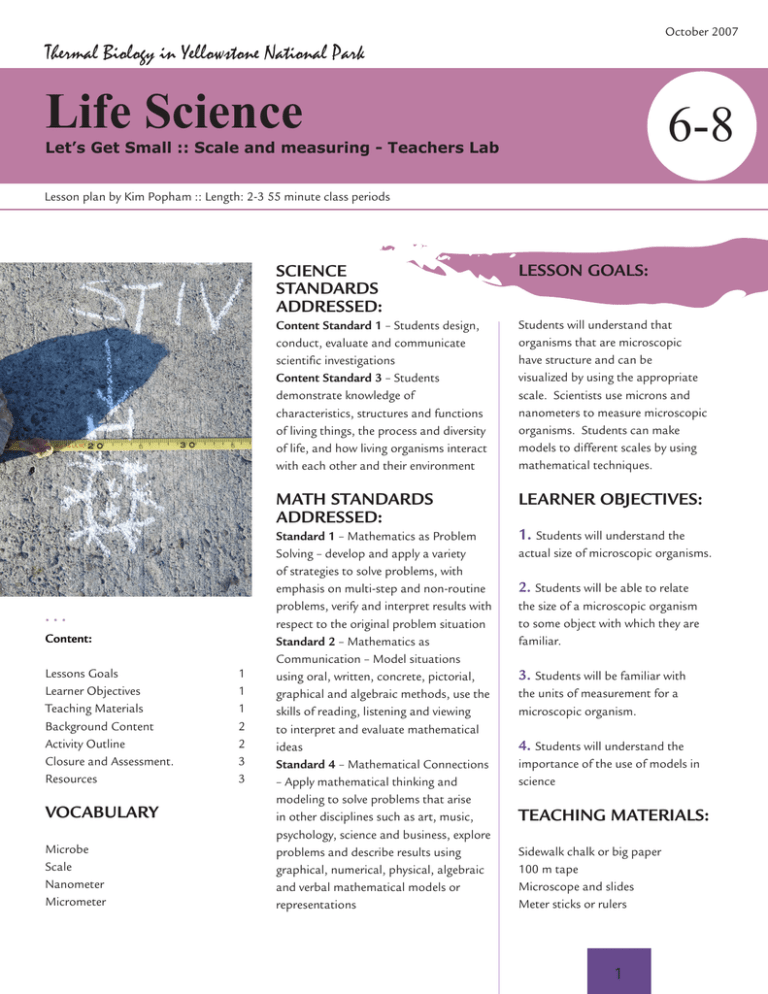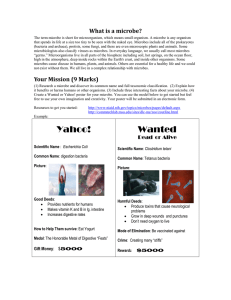Teachers Lab PDF
advertisement

October 2007 Thermal Biology in Yellowstone National Park Life Science 6-8 Let’s Get Small :: Scale and measuring - Teachers Lab Lesson plan by Kim Popham :: Length: 2-3 55 minute class periods ••• Content: Lessons Goals Learner Objectives Teaching Materials Background Content Activity Outline Closure and Assessment. Resources Vocabulary Microbe Scale Nanometer Micrometer 1 1 1 2 2 3 3 Science Standards Addressed: Lesson Goals: Content Standard 1 – Students design, conduct, evaluate and communicate scientific investigations Content Standard 3 – Students demonstrate knowledge of characteristics, structures and functions of living things, the process and diversity of life, and how living organisms interact with each other and their environment Students will understand that organisms that are microscopic have structure and can be visualized by using the appropriate scale. Scientists use microns and nanometers to measure microscopic organisms. Students can make models to different scales by using mathematical techniques. Math Standards Addressed: Learner objectives: Standard 1 – Mathematics as Problem Solving – develop and apply a variety of strategies to solve problems, with emphasis on multi-step and non-routine problems, verify and interpret results with respect to the original problem situation Standard 2 – Mathematics as Communication – Model situations using oral, written, concrete, pictorial, graphical and algebraic methods, use the skills of reading, listening and viewing to interpret and evaluate mathematical ideas Standard 4 – Mathematical Connections – Apply mathematical thinking and modeling to solve problems that arise in other disciplines such as art, music, psychology, science and business, explore problems and describe results using graphical, numerical, physical, algebraic and verbal mathematical models or representations 1. Students will understand the actual size of microscopic organisms. 2. Students will be able to relate the size of a microscopic organism to some object with which they are familiar. 3. Students will be familiar with the units of measurement for a microscopic organism. 4. Students will understand the importance of the use of models in science Teaching Materials: Sidewalk chalk or big paper 100 m tape Microscope and slides Meter sticks or rulers 1 Background content: While diseases caused by microbes are very important, there are many microbes that are useful and even beneficial to our everyday lives. Many microbes produce the oxygen we breathe. Pond water is full of these organisms. People could not survive without intestinal bacteria creating essential vitamins and helping digest the food we eat. We would not have cheese, wine or antibiotics without microbes. However, can you see organisms as small as bacteria and viruses? Most often you cannot. Sometimes, though, they live in colonies that become so large that we are able to see the colony. These microbial mats can be seen in the hot springs found in Yellowstone National Park. Generally, we use millimeters to measure “small” things, but you learn in this activity that microscopic microbes are ultra- small so millimeters are actually too big to measure them. Scientists measure microbes by using micrometers (microns) or nanometers. One micrometer is written as 0.000001 m. A micrometer is a thousand times smaller than a millimeter and a nanometer is one million times smaller than a millimeter. Because these microbes are so small, scientists often use models to help us study and understand these small subjects. Anticipatory Set: Ask students what their idea of scale is. Many of them will tell you it is something with which you determine your weight. Then, show them pictures of a human blood cell and other examples of microbes asking students if those pictures are the actual size of the cells. Students should know those pictures are larger than the actual cells, but that they are in proportion to the real thing. Explain that this is what we mean by scale. Showing students a set of blueprints and telling them that their house is built to the scale of the blueprint. Also, show them the map of Yellowstone and explain how to use the map scale and what it means. Now, tell students they are going to draw some microbes to scale, but instead of going from larger (the house and the park) to smaller (blueprints and the map) they are going to go from the small object (the microbe) to something larger (their drawing). Introduce the measurement of nanometers. Since microbes are so small, scientists must use a measurement that is small enough to make measuring the microbes manageable. A nanometer is 10-9m which is written as 0.000000001 m. Activity Outline: DAY BEFORE ACTIVITY – Find an area which you can use for your class or classes that won’t be disturbed and that students can draw on the floor or ground with sidewalk chalk. You could also use the hallway and have students draw their pictures on paper to be placed next to measuring tape. The area must be at least 50 meters long. DAY 1 OF ACTIVITY – 1. Break students into groups of 3-4 depending on class size 2. Students should examine a piece of hair under the microscope or magnifying glass. If possible, use a ProScope and take a picture of the piece of hair 3. Have students look at prepared slides of bacteria and paramecium 4. Discuss the relative size of the bacteria, their hair and a paramecium 5. Answer questions in procedure 1 and 2 on the student version DAY 2 OF ACTIVITY – 6. Move students to “drawing” area – you should have a measuring tape stretched out to 50 meters so students can use it to measure 7. Each group should choose or be assigned a different microbe from the Microbe Reference Chart. 8. Have students determine the size of their drawing they should be using a ratio of actual size to drawing size. 9. A piece of human hair is on average 0.1 mm or 100 microns in width therefore the ratio should be set up as follows: 2 Example: Closure/ Assessment: actual size of microbe actual size of hair= scale size of microbe scale size of hair 10 microns = 100 microns X m (red blood cell) 50 m (hair) .01= 50*.01= Xm/50m 5 m (meters) = X Xm 10. Students draw a picture of their microbe using the sidewalk chalk or paper and markers – their picture should be drawn in comparison to the piece of hair they looked at earlier if that hair was 50 meters in width. Their picture should be the size they determined earlier. 11. Check each group’s picture and then give them the actual size of the microbe they chose – have students redraw their picture so that it is to scale of the hair. For example if the microbe is 0.09 microns the drawing should be 0.045 meters or 4.5 cm. 12. Have students look at other pictures Students correctly determine the correct size for their microbe drawing Complete questions Students can explain to their instructor the system of measurement for microbes Resources: http://www.microbeworld.org/ resources/experiment/experiment_lets_ get_small.aspx http://www.tbi.montana.edu/ http://micro.magnet.fsu.edu/optics/ activities/students/perspectives.html 3 Microbe Habitat or function Actual Size Shape 50 meter scale size STIV High temp. virus that infects Sulfolobus 0.070-0.090 microns 0.035-0.045 meters OR 3.5-4.5 centimeters Sulfolobus High temp. Archaea pH 2-3 Temp. 80-90oC 1.5 microns 0.75 meters OR 75 centimeters Cyanidia Acidophilic algae pH 2-3 Temp. 45-57oC 7 microns 3.5 meters Synechococcus High temp. cyanobacteria 1 - 5 microns pH 6-9 Temp. 45-72oC 0.5-2.5 meters Oscillatoria High temp. cyanobacteria 7 - 18 microns pH 5-9 Temp. 37-54o C 9 meters Metallosphaera Iron oxidizing high temp. archaea pH 1-5 Temp. 50-80oC 1 micron 0.5 meters Paramecium Common protozoa important in the food chain 200 microns (you can almost see it) 100 meters Escherichia coli (E. coli) Causes diseases and helps digestion 3 microns 1.5 meters Human red blood cell Carries oxygen in our bodies 10 microns 5 meters Human hair Protects our bodies from the elements 100 microns 50 meters



